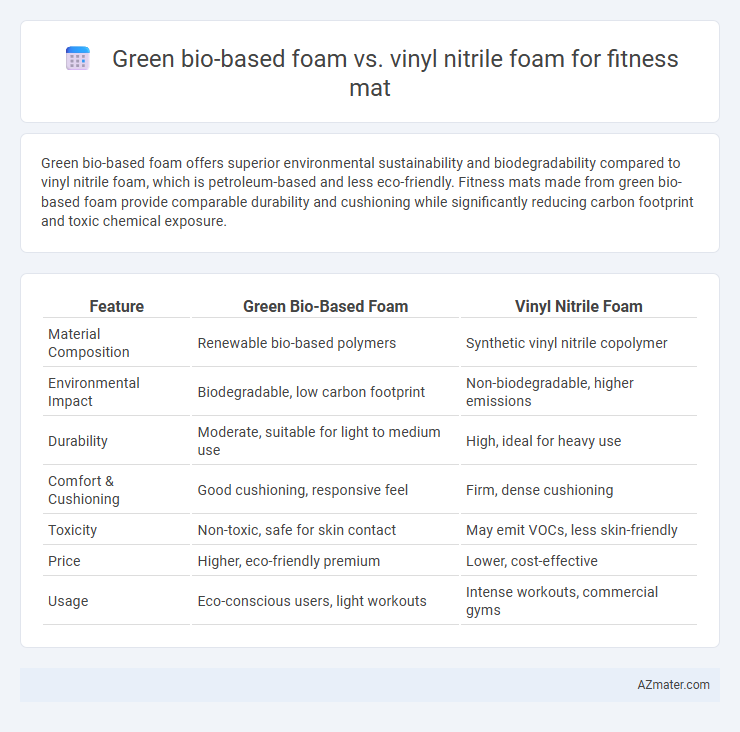Green bio-based foam offers superior environmental sustainability and biodegradability compared to vinyl nitrile foam, which is petroleum-based and less eco-friendly. Fitness mats made from green bio-based foam provide comparable durability and cushioning while significantly reducing carbon footprint and toxic chemical exposure.
Table of Comparison
| Feature | Green Bio-Based Foam | Vinyl Nitrile Foam |
|---|---|---|
| Material Composition | Renewable bio-based polymers | Synthetic vinyl nitrile copolymer |
| Environmental Impact | Biodegradable, low carbon footprint | Non-biodegradable, higher emissions |
| Durability | Moderate, suitable for light to medium use | High, ideal for heavy use |
| Comfort & Cushioning | Good cushioning, responsive feel | Firm, dense cushioning |
| Toxicity | Non-toxic, safe for skin contact | May emit VOCs, less skin-friendly |
| Price | Higher, eco-friendly premium | Lower, cost-effective |
| Usage | Eco-conscious users, light workouts | Intense workouts, commercial gyms |
Introduction to Fitness Mat Materials
Green bio-based foam for fitness mats offers eco-friendly advantages with natural, renewable ingredients that reduce environmental impact while maintaining durability and comfort. Vinyl nitrile foam, widely used for its superior cushioning, water resistance, and long-lasting support, provides excellent shock absorption and firmness for various workout activities. Comparing both, green bio-based foam prioritizes sustainability and non-toxic properties, whereas vinyl nitrile foam emphasizes performance and moisture resistance.
What is Green Bio-Based Foam?
Green bio-based foam is an eco-friendly material derived from renewable resources such as plant oils and natural fibers, offering a sustainable alternative to traditional synthetic foams like vinyl nitrile foam. It provides excellent cushioning, durability, and resistance to moisture, making it ideal for fitness mats that prioritize environmental impact without compromising performance. Compared to vinyl nitrile foam, green bio-based foam reduces reliance on petroleum-based products and lowers carbon emissions in the manufacturing process.
What is Vinyl Nitrile Foam?
Vinyl nitrile foam is a synthetic material renowned for its high durability, resilience, and resistance to oil, chemicals, and temperature variations, making it ideal for fitness mats requiring long-lasting performance. Unlike green bio-based foam, which prioritizes sustainability, vinyl nitrile foam offers superior cushioning and shock absorption, enhancing joint protection during workouts. Its closed-cell structure prevents moisture absorption, reducing odor and promoting hygiene in fitness environments.
Sustainability and Environmental Impact
Green bio-based foam for fitness mats significantly reduces carbon footprint by utilizing renewable resources like plant oils and agricultural byproducts, making it biodegradable and compostable. Vinyl nitrile foam, derived from synthetic petroleum-based materials, poses challenges due to its non-biodegradability and contributions to microplastic pollution. Choosing bio-based foam enhances sustainability by minimizing environmental harm and promoting circular economy principles in fitness equipment manufacturing.
Durability and Longevity Comparison
Green bio-based foam demonstrates superior durability and longevity compared to vinyl nitrile foam in fitness mats, resisting compression and wear over extended use. Its natural polymer structure offers better resilience against sweat, UV exposure, and temperature fluctuations, reducing material breakdown and deformation. Vinyl nitrile foam tends to degrade faster under similar conditions, leading to decreased cushioning and support over time.
Comfort and Cushioning Properties
Green bio-based foam for fitness mats offers superior comfort and cushioning due to its natural flexibility and resilience, providing effective shock absorption and pressure distribution during workouts. Vinyl nitrile foam, while durable and resistant to wear, tends to be denser and less breathable, which can result in a firmer, less comfortable surface over extended use. The eco-friendly composition of green bio-based foam also enhances moisture-wicking properties, reducing discomfort caused by sweat and improving overall exercise experience.
Safety and Non-Toxicity Factors
Green bio-based foam offers a significant advantage in safety and non-toxicity for fitness mats due to its natural, renewable materials free from harmful chemicals and volatile organic compounds (VOCs). Vinyl nitrile foam, while durable and resistant to wear, typically contains synthetic polymers that may off-gas toxic substances over time, posing potential health risks during prolonged use. Choosing bio-based foam supports safer workout environments by minimizing allergenic reactions and chemical exposure commonly associated with traditional synthetic foams.
Price and Cost-Effectiveness
Green bio-based foam offers a competitive price point due to sustainable raw materials that often reduce manufacturing expenses compared to traditional vinyl nitrile foam. Vinyl nitrile foam, while typically more expensive upfront, provides greater durability and resistance, potentially lowering replacement frequency and long-term costs. Evaluating total cost-effectiveness requires weighing initial investment against lifespan and environmental impact for fitness mat applications.
Performance for Different Fitness Activities
Green bio-based foam offers superior breathability and eco-friendly cushioning, making it ideal for yoga and Pilates that require comfort and moisture control. Vinyl nitrile foam provides excellent shock absorption and durability, supporting high-impact activities like aerobics and HIIT with enhanced joint protection. Both materials optimize performance by catering to specific fitness demands, balancing resilience and comfort for varied workout intensities.
Which Fitness Mat Foam is Right for You?
Green bio-based foam offers superior eco-friendliness and biodegradability compared to traditional vinyl nitrile foam, making it ideal for environmentally conscious fitness enthusiasts. Vinyl nitrile foam provides excellent durability, cushioning, and moisture resistance, ensuring long-lasting performance for high-intensity workouts. Choosing the right fitness mat foam depends on whether you prioritize sustainability with green bio-based foam or enhanced durability and support with vinyl nitrile foam.

Infographic: Green bio-based foam vs Vinyl nitrile foam for Fitness mat
 azmater.com
azmater.com